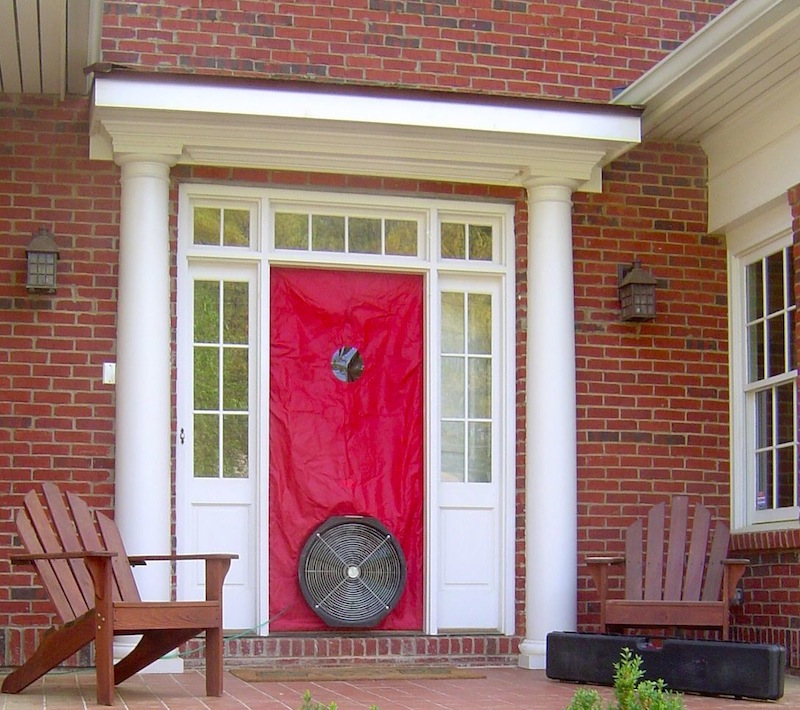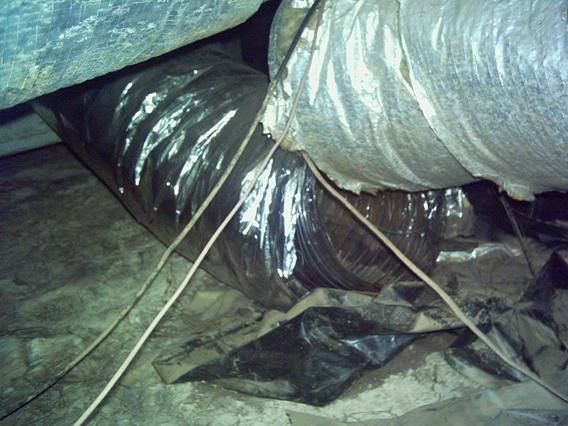It’s the Hole – Understanding What a Blower Door Is for

There’s been a lively discussion going on in the RESNET/BPI group on LinkedIn. I posted my article about how infiltration occurs at the surface, not in the volume, and it’s generated some good comments. In that article, I said we need to stop talking about infiltration rates in terms of air changes per hour because there are too many problems with it.
Reading and responding to the LinkedIn comments has refined my thinking on the issue, so let’s see if I can convince the holdouts.
Infiltration* is caused by two things:
- a pressure difference
- a pathway
If the pressure outside a building is the same as the pressure inside, you can open all the windows, and little air will move through them. Likewise, you can have a huge pressure difference across the building envelope, but if there are no holes, there’s no air leakage. So, if you eliminate one or the other of those two conditions, you eliminate the infiltration.
Now, the Blower Door is really good at telling us about the pathway, that is, the hole in the house. The more air flow a Blower Door measures, the bigger the hole in the house. (When I say ‘hole,’ singular, I’m referring to the sum of all the leakage sites.)
What the Blower Door cannot do, however, is tell us anything about the pressure differences that the home experiences. When the Blower Door is operating, it puts the house under a controlled pressure difference. When the Blower Door is not running, the pressure in the house varies season to season and moment to moment. The driving forces for those changes are wind, the stack effect (warm air rising in the house), and mechanical systems.
Calculating the ACHnat based on a single point test attempts to factor in the effects of wind and stack effect, but at great cost to the precision. You go from ~3% uncertainty to 20%, 30%, possibly even 50% or more. I don’t think it’s helpful to tell a homeowner, “Your home leaks at the rate of 1 air change per hour…but it could be as low as 0.5 or as high as 1.5, and if you’ve got problems with the mechanical systems, it could even be 2 or more air changes per hour.”
Pressure differences created by mechanical systems can eclipse those created by wind and the stack effect. The disconnected supply duct, the panned return, the 1200 cfm commercial range hood with no makeup air – all these things can dwarf the effects we’re trying to capture in ACHnat.
mechanical systems can eclipse those created by wind and the stack effect. The disconnected supply duct, the panned return, the 1200 cfm commercial range hood with no makeup air – all these things can dwarf the effects we’re trying to capture in ACHnat.
I believe that the pathways for infiltration are really all we need to be concerned with when we’re talking about Blower Door results. If a house has a hole, we want to know how big it is and what we can do to make it smaller. That’s what the Blower Door is good at. We can still help homeowners without extrapolating to the point of meaninglessness if we just focus on the hole.
My point about normalizing the raw number, cfm50, to the surface area rather than the volume makes sense when you see it this way. If you’ve got a hole in the building envelope, you compare it to the size of the building envelope, not the volume.
Yes, pressure differences are important, but let’s understand the limitations of the Blower Door. It’s great at telling us about the pathways for air leakage through the building envelope. It can’t tell us anything about the normal pressure differences a building will experience.
*When I talk about infiltration, I’m using that word to describe both the air that enters a building through the leaks and the air that leaves the building through leaks. Technically, those are infiltration and exfiltration, respectively, but I’m going to allow you to do a little of the work and understand that I’m talking about all of the leakage.
This Post Has 4 Comments
Comments are closed.

Allison, I believe you are
Allison, I believe you are correct. The only valid reason to look at volume with a blower door test is to calculate the MVR.
There are various measurements of surface leakage. Canadian EqLA @ 10 pa; LBL ElA @ 4 pa; MPLS Leakage Ratio; rule of thumb 10% of CFM@50; others
What are the practical differences and which should auditors be using to explain to HO and contractors what to look for?
Thanks for your comment, John
Thanks for your comment, John. I’m not sure it’s worth combining Blower Door results with volume for ventilation, either. I’ll write about that in a future article.
Regarding the various ways of characterizing the results, I prefer ELR (cfm50/sfbe). MLR is similar (above grade surface area only) and also useful. I’m not a huge fan of the leakage areas because again, you get into extrapolating a bit too far. Determining the actual size of the leakage area from the cfm50 is tricky because the size and shape of the hole comes into play. I like it for approximations, though, and often tell people that each square foot of leakage area gives you about another 1000 cfm50.
You’ve out-geeked me, once
You’ve out-geeked me, once again.
Bailes, you rule.
I think you are right about
I think you are right about what information, and how we present that information to the homeowner is key to helping them understand what the problems are. ELR(cfm50/sfbe) is much easier to explain, and much more understandable for the homeowner and most contractors. We have to remember, we are trying to show them what they need to do to improve energy effeciency, not show them how much technical information we can generate.